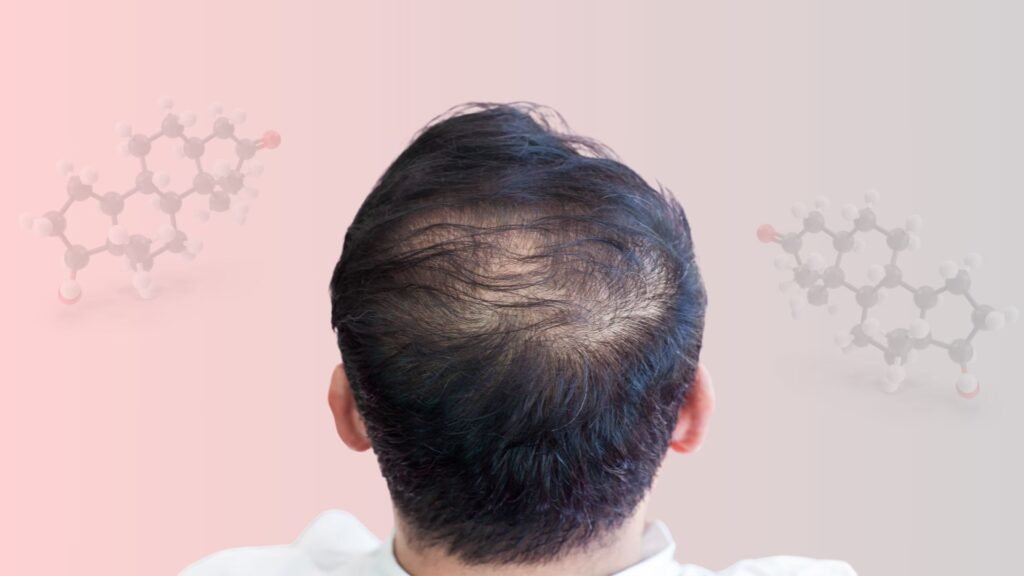DHT Blockers: Ultimate Guide to Remove DHT from Scalp for Hair Loss

Ever wondered why your hairline is receding or why your crown feels thinner every time you look in the mirror?
You are not alone; hair loss is a typical problem that many people face. And if you’ve been Googling “how to stop hair fall”, chances are, DHT has something to do with it.
But here’s the kicker: you don’t need surgery, overpriced serums, or a bathroom shelf full of miracle cures. The real fix starts with understanding what’s silently working against your scalp—and how to stop it.
DHT (dihydrotestosterone) is a hormone that silently accumulates and reduces your hair follicles, making them grow thinner, weaker hairs—until eventually, they stop growing at all. If you’re noticing symptoms such as a receding part, thinning crown, or sudden hair loss, DHT is probably the offender.
In this guide, we’ll walk you through:
- What DHT really is and how it affects your follicles
- The best natural DHT blockers that actually work
- A 4-week regimen to recover your scalp health—with no side effects or guessing.
Let’s demystify the science, shatter the myths, and give you a strategy that works.
What Is DHT And How Does It Impact Hair Follicles?
DHT is a hormone made from testosterone.. While it is important in the development of male characteristics, it’s also the major culprit of shrinking hair follicles, leading to hair thinning and eventual baldness.
How DHT Works:
- Binding to Receptors: If DHT attaches to receptors in your scalp, it reduces the length of the growth phase and prolongs the shedding phase. What this translates to is your hair not getting sufficient time to grow to its maximum before falling off.
- Follicle Miniaturization: This causes thinning of the hair, especially in pattern baldness (both men’s and women’s).
The significance of knowing this connection is that it helps determine how to prevent it.
You can’t remove DHT completely—but you can block its effects on your scalp.
Causes of High DHT Levels on the Scalp
DHT isn’t something that just happens overnight. Several factors contribute to its rise:
- Genetics: If there is a history of baldness in your family, then you could have a predisposition for excess DHT. The process of converting testosterone to DHT in your body is, like most biological processes, based on your genetics.
- Excess Testosterone: Excess testosterone is made in your body that gets converted to excess DHT, and that is the reason for baldness.
- Hormonal Imbalance: Overproduction of DHT is caused in most cases due to unhealthy diet, lack of sleep, and stress.
- Inflammation: Scalp inflammation due to poor hygiene or irritating hair products can amplify the destruction caused by DHT to your follicles.
Knowing the cause of heightened DHT could inform your treatment strategy in combating it effectively.
How to Remove DHT from the Scalp
Here’s your action plan for reducing DHT on your scalp. You don’t have to try everything—just follow the steps that make sense for you and your routine.
1. Use a DHT Blocker Shampoo
Use a DHT-blocking shampoo with an active ingredient like ketoconazole to reduce how much DHT impacts your follicles. Use shampoos specifically designed to inhibit DHT.
Top Ingredients to Consider:
- Ketoconazole: Anti-fungal drug that also inhibits DHT
- Saw Palmetto: Natural suppressor of DHT.
- Biotin: Supports the strength and growth of hair.
- Caffeine: Encourages growth of hair follicles.
For instance, saw palmetto and pumpkin seed oil shampoos have been shown to reduce DHT levels on the scalp.
2. How To Incorporate Natural DHT Blockers
Use a DHT-blocking shampoo with an active ingredient like ketoconazole to reduce how much DHT impacts your follicles. Use shampoos specifically designed to inhibit DHT.
Top Ingredients to Consider:
- Ketoconazole: Anti-fungal drug that also inhibits DHT
- Saw Palmetto: Natural suppressor of DHT.
- Biotin: Supports the strength and growth of hair.
- Caffeine: Encourages growth of hair follicles.
For instance, saw palmetto and pumpkin seed oil shampoos have been shown to reduce DHT levels on the scalp.
3. Take Oral DHT Blockers (If Prescribed)
Take Oral DHT Blockers (If Prescribed)
There are also oral medications that block DHT, including finasteride. These are only available through prescription and are typically saved for serious cases of baldness.
Disclaimer: Consult a medical doctor before administration of any drug.
4. Use Topical DHT Blockers
Topical therapies like minoxidil act directly on hair follicles. They don’t directly inhibit DHT, but they encourage the growth of more robust hair, which runs counter to the action of DHT.
Application Tips:
- Apply to the scalp as directed.
- Consistency is key—results may take several months.
5. Eat Smart to Block DHT Naturally
What you eat can directly influence your hormone levels. EG: Eat plenty of zinc-, lycopene-, and omega-3 fatty acid-rich foods.
Top DHT-Blocking Foods:
- Tomatoes (rich in lycopene)
- Spinach (rich in zinc)
- Chia Seeds (omega-3s)
- Green Tea: EGCG Inhibits DHT Production
You should include these foods in your daily diet to promote hair health.
6. Maintain Scalp Cleanliness
A clean scalp is essential. So, too much oil and buildup can exacerbate scalp inflammation, which increases DHT’s effect.
Tips for Scalp Hygiene:
- Wash your hair frequently with a gentle shampoo.
- Avoid heavy styling products that will clog pores.
7. Reduce Stress and Sleep Well
Stress is also one of the leading causes of increased levels of DHT. You need to do relaxation exercises regularly like yoga, meditation, or breathing exercises. Adequate rest also enables your body to regulate your hormones, as well as manage DHT levels.
Stress-Reduction Techniques:
- Mindfulness Meditation: Lowers cortisol levels.
- Maintain a regular exercise: Hormones gets a balance by exercising regularly.
- Adequate Rest: 7-9 hours sleep nightly.
8. Boost Circulation with Scalp Massage
Not only is it a quick, easy way to give your scalp a mini-massage, but it also helps to boost circulation.
A 5-minute scalp massage each day will amplify circulation and lessen the impact of DHT on your hair follicles. It increases nutrient circulation and encourages hair growth.
How to Massage:
- You can either rotate your toes gently with finger pads.
- You can additionally use oils like peppermint or rosemary for added benefits.
9. Reduce Over-Styling and Chemical Products
Harsh chemicals, heat styling, and tight styles don’t produce DHT themselves—but they do weaken your hair follicles so that they’re more prone to the damage that DHT already causes.
Watch out for:
- Frequent straightening or curling
- Tight ponytails or braids (traction alopecia)
- Hair dyes with ammonia or bleach
- Alcohol-heavy styling products
Pro tip: Opt for DHT-safe hair regimens—apply heat-protective sprays, try sulfate-free shampoos, and reduce chemical treatments.
Best Shampoo for DHT Blocking: What to Look For
Selecting the best shampoo for DHT is not about reaching for the most costly bottle on the shelf. It’s about ingredients, formulation, and consistency.
Here’s what your shampoo needs to have
|
Ingredient |
Why It Works |
|
Saw Palmetto |
Naturally inhibits 5-alpha-reductase (DHT) |
|
Ketoconazole |
Antifungal that helps block DHT |
|
Caffeine |
Boosts blood flow to hair follicles |
|
Biotin |
Strengthens hair strands |
|
Pumpkin Seed Oil |
Natural DHT blocker and anti-inflammatory |
|
Niacin (B3) |
Improves scalp circulation |
Tip: Leave shampoo on your scalp for 2–3 mins before rinsing, as this will help with the absorption of the ingredients.
Product Example: A “shampoo containing 1% ketoconazole and saw palmetto,” is a favorite in dermatologic practice, combining a dual barrel assault on both dandruff and DHT.
Natural DHT Blockers: Do They Really Work?
Yes—with consistency.
Natural DHT blockers are your body’s best allies in managing hair loss—especially if you’re in the early stages or want to take a holistic route. They don’t carry the same side effects as prescription medications and can often be integrated into your diet or hair care regimen effortlessly.
Realistic Expectations:
- You won’t see overnight regrowth, but you will slow down the rate of loss.
- Results may take 3–6 months depending on your routine and consistency.
Combining multiple approaches (diet + topical + lifestyle) yields better results.
Hair Fall Prevention Plan: A 4-Week Jumpstart Routine
Here’s a simple 4-week plan to help you kickstart your anti-DHT routine and stop hair fall in its tracks.
Week 1: Detox Your Scalp
- Switch to a DHT-blocking shampoo.
- Exfoliate your scalp once with a scrub or brush.
Cut out any heavy gels, waxes, or alcohol-based products.
Week 2: Start Natural Blockers
- Begin taking saw palmetto or pumpkin seed oil supplements.
- Add green tea or matcha to your morning routine.
Introduce biotin-rich foods like eggs and spinach.
Week 3: Boost Circulation
- Do a daily 5-minute scalp massage with peppermint or rosemary oil.
- Add light cardio (30 mins) to your routine 3x/week to regulate hormones.
Consider microneedling once a week under professional guidance.
Week 4: Monitor and Adjust
- Take scalp progress pictures.
- Note hair fall during showers or combing.
Stick with your routine and adjust based on what your scalp responds to best.
Myths About DHT and Hair Loss You Should Ignore
Let’s bust some common myths so you can focus on what actually works:
Myth: “Shaving your head will reduce DHT.”
Truth: Hair shaving doesn’t impact DHT levels—it’s hormonal.
Myth: “Only men need to worry about DHT.”
Truth: Women experience DHT-related hair thinning too—especially post-pregnancy or during menopause.
Myth: “Natural DHT blockers are placebo.”
Truth: Clinical studies have shown saw palmetto and pumpkin seed oil help reduce DHT levels significantly.
Who Should Consider DHT Blocking?
Blocking DHT is especially effective if you fall under these categories:
- Men and women with early signs of hair thinning
- Individuals with a family history of pattern baldness
- Anyone looking for a natural and sustainable way to manage hair health
- Those who’ve tried other treatments but want to avoid side effects
And if you’re someone actively Googling “how to stop hair fall,” you’re definitely in the right place.
When to See a Hair Specialist
If hair fall persists despite your best efforts—or if you’re experiencing patchy bald spots, sudden shedding, or scalp irritation—it’s time to bring in a pro.
A Specialist can:
- Run scalp health tests
- Check for hormonal imbalances
- Prescribe medical-grade DHT blockers
- Customize your treatment plan
Early intervention = more hair saved.
Final Thoughts: Can You Really Stop Hair Fall?
Stopping hair fall isn’t about miracles—it’s about method. DHT might be the villain, but you now have the blueprint to fight back.
> Switch to a DHT-blocking shampoo
> Incorporate natural DHT blockers into your daily routine
> Stick to a scalp-friendly lifestyle
> Be consistent—and patient
Remember: the best results come from a combination of prevention and treatment. Whether you’re just noticing thinning or you’ve been battling it for years, it’s never too late to take control of your hair story.
FAQs
Does DHT cause dandruff?
DHT doesn’t directly cause dandruff but can increase scalp oil, which may trigger dandruff by feeding fungi like Malassezia.
How can I stop DHT naturally?
If you’re trying to stop DHT naturally, focus on eating the right foods, using herbs like saw palmetto, caring for your scalp, and keeping stress and hormones in check.
Does sweat contain DHT?
Sweat itself doesn’t contain DHT, but DHT can be present on the scalp and mix with sweat, especially in areas with high oil production.
Does exercise reduce DHT?
Exercise doesn’t directly reduce DHT, but it helps balance hormones, reduce stress, and improve circulation — all of which can indirectly lower DHT levels or reduce its impact.
Which food increases DHT?
Foods high in saturated fats, sugar, and cholesterol can increase DHT levels — like red meat, dairy, fried foods, processed snacks, and sugary treats.

